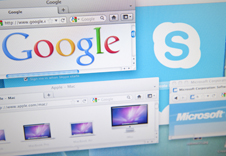3Qs: Microsoft trying to take another bite of the Apple?

It was recently announced that Apple, assessed at $150 billion, surpassed Google as the world’s most valuable brand. This comes a year after overtaking Microsoft as the globe’s most valuable technology company. The day after the announcement, Microsoft made its biggest purchase to date, buying Skype for $8.5 billion. Here, Andrew Rohm, associate professor of marketing at Northeastern University, assesses the branding and marketing strategies employed by these goliath companies and whether Microsoft’s new purchase was in direct response to Apple’s success.
Did Microsoft purchase Skype in response to Apple’s dominance? Will Microsoft continue to purchase other established companies?
Microsoft purchased Skype to better position itself to compete with leading technology brands such as Apple and Google. Skype has helped to pioneer Internet-enabled phone calls and has approximately 170 million users per month. With the purchase, Microsoft gains significant scope in the emerging field of Internet communications, a field in which Google already competes with its search capabilities as well as its own competing suite of services similar to Skype’s.
In addition, Apple’s Mac v. PC commercials of a couple of years ago positioned Microsoft publicly as an un-cool, un-hip technology laggard. So, yes, the Skype deal is absolutely in response to Microsoft’s efforts to shift its brand image and become a major player in the fastest growing area of person-to-person and business-to-business communications, including Internet video communications and conferencing.
Experts note that the $8.5 billion that Microsoft has agreed to pay for Skype is a lot to pay for a company with only $860 million in revenues and that actually lost money in 2010.
How do the marketing strategies for trendsetting companies like Apple or Google differ from a PC-based company like Microsoft? How will adding a video-chat service, such as Skype, bolster Microsoft’s brand?
Apple is a trendsetter, first because of its radical product innovations. Its marketing is brilliant because it’s closely aligned with its product design: through simplicity and focus on consumer benefits more than the features of the product. This applies to its Apple retail stores as well as its television commercials. On the other hand, Microsoft is perceived as a monopolistic company whose brand has suffered with past miscues such as its less-than-helpful paperclip thingy and its Vista operating system. The addition of Skype can boost the Microsoft brand if it is able to successfully integrate the benefits that Skype currently offers individuals and businesses into its existing and future home and business products. For example, one way that Skype can make Microsoft “sexy” again would be to integrate Skype’s voice and video messaging platforms with Microsoft’s e-mail, Xbox Kinect and mobile platforms. This could result in a pretty cool in-home gaming and video communications system.
What strategies can Microsoft employ to compete with these innovative companies?
The best innovation companies and brands build from within and are able to stay ahead of what consumers are looking for with their product development. Some call this the “wow” factor and it certainly applies to what Apple, Google and Skype have achieved. Microsoft has several strengths, namely its Office suite of products and its Xbox franchise, and integrating Skype into these existing products could substantially help the company compete in the Internet communications arena. Perhaps more importantly, for Microsoft to be competitive in the near future, it needs to somehow leverage Skype with its lagging mobile communications and data platforms. There lies the future of consumer and business communications.





